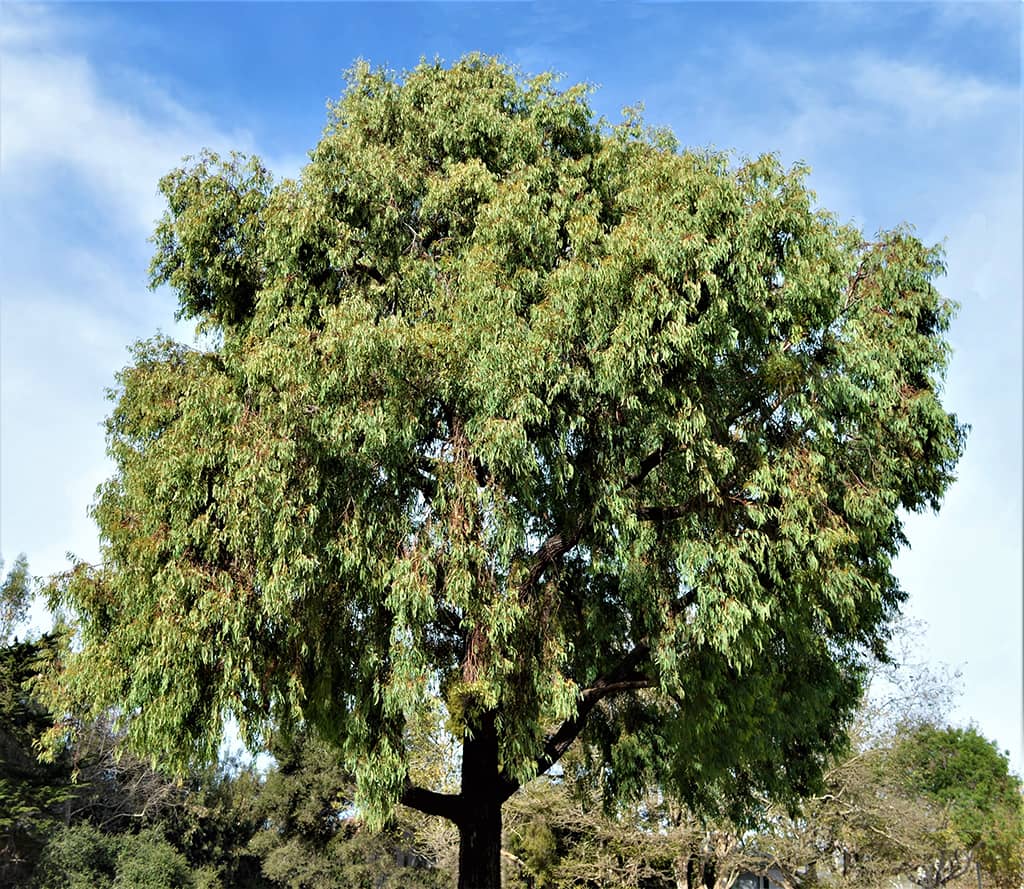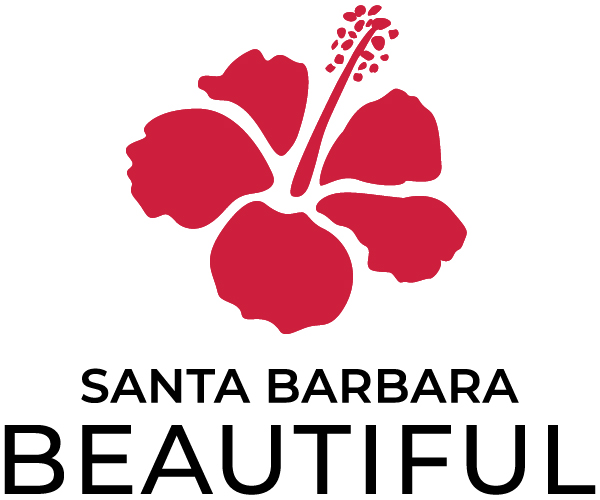Santa Barbara Beautiful Tree of the Month – January 2021

Eucalyptus sideroxylon
The Red Ironbark is a beautiful broadleaf evergreen tree that is truly remarkable in the great variability of its size, growth habit, bark, and flower color. This can make identifying it—or even describing it—a bit tricky.
At maturity, Red Ironbark can develop into either a small-, medium-, or large-sized tree. Its full size can range widely—in height from 30 to 80 feet—and in canopy spread from 20 to 60 feet. It can have a branching structure that can vary from a broad round-headed crown with upright branches to a narrow crown with pendulous branches.
Its bark is tough and thick; it can be either black, dark brown, or light gray in color—and will present vertical fissures that may, or may not, have a deep rusty-red coloring. It is a Eucalyptus but is unusual in that genus because it is the only Euc species to have bark which can be black. Like only a few other Eucalyptus species, its bark never sheds off the trunk.
The Red Ironbark’s flowers are also quite variable. They are always seen as a fluffy circle of ¼ inch long stamens but can be either red, white, pink, or creamy yellow in color. From November to February, the ½-inch wide flowers bud out and then open, hanging in clusters of 3 or 7 flowers. These are “perfect flowers”, meaning each flower has both male parts (stamens) and female parts (pistils).
The flowers bloom in such great abundance that they attract huge numbers of bees; the loud hum of their activity can be heard a hundred feet from the tree! Beekeepers in Australia like to place hive boxes near Red Ironbark woodlands because the gorging bees will produce large quantities of delicious Eucalyptus-fragrant honey.
After the flowers are pollinated, glossy red-brown spherical seed pods grow and then develop into urn- or cup-shaped capsules that fill with hundreds of brown seeds as tiny as grains of sand. Amazingly, these diminutive seeds can grow into enormous trees.
The leaves are always lance-shaped but can be otherwise quite variable, depending on their age and the time of year. Young leaves are light-green and up to 6 inches long and 1 inch wide. Older leaves usually fade to a dull green but sometimes develop a bluish-gray color on both sides with red margins. In the winter, they can change to a lovely bronze color.
In addition to its service as an ornamental shade tree in the urban landscape, this tree has many other uses. Its wood is extremely hard and dense—so dense that it will not float in water! Being very resistant to rot and decay, it has long been valued for use in the building of fences, piers, boats, and furniture. It makes good firewood. Its leaves can be processed to extract the cineole-based Eucalyptus oil called eucalyptol. Its pleasant and refreshing aroma and taste make it a common ingredient in many flavorings, fragrances, and cosmetics. Eucalyptol is an ingredient in many commercial mouthwashes, and has been used in traditional medicine as a cough suppressant. It has also been used for centuries as a folk medicine to treat a variety of common diseases and conditions.
Red Ironbark is endemic to Eastern Australia and is found in abundance in forests and woodlands from south-eastern Queensland through New South Wales to Victoria. In its native regions, it is also known as the “Mugga Ironbark”.
Coming from a climatic region with periodic droughts like ours, Red Ironbark is perfectly suited to the Santa Barbara growing environment—and it does very well here. It is drought tolerant since it can survive on less than 15 inches of rain per year. It is cold hardy to 15-20 degrees F. It is medium- to fast-growing. It can thrive in many types of soil, if well-drained; however, its leaves do tend to become chlorotic (yellow) if planted in a soil with heavy clay. It does not seem to have any serious problems with plant diseases or insect pests.
That said, some important considerations should be taken in its siting and maintenance. Unless you can select a small pendulous variety, you should plan on the tree becoming large—give it sufficient space so that it can grow naturally to its full height and width. Its surface roots can lift up adjacent hardscape—plant it away from sidewalks, walls, and foundations. As the tree matures, it will be necessary to prune it regularly—thinning the crown and lightening heavy branches—to avoid damage from falls of any heavy limbs broken off in windstorms.
The botanical name for the Red Ironbark is Eucalyptus sideroxylon. The genus name, Eucalyptus, is a combination of the Greek words, “eu” (meaning “well”) and “kalypto” (meaning “covered”)—it refers to the woody caps that protect the flower buds. The specific epithet, sideroxylon, is a combination of the ancient Greek words “sideros” (meaning “iron”) and “xylon” (meaning “wood”)—it refers to the iron-hard wood.
There are several varieties and cultivars that have been selected for nursery propagation, based primarily on their flower color. The most common is ‘rosea’, with the common name “Red Flowered Ironbark”. There is also a lovely one called “Pink Flowered Ironbark”.
Red Ironbark trees have been planted in our area since the late 1800s. They stand as ornamentals in private gardens, as street trees, as park trees, and in commercial landscapes. They can be used as featured specimen trees or as screens and windbreaks.
Mature Red Ironbarks stand on Las Positas Road (in front of Adams School and along the Municipal Golf Course), on Vista Del Mar, on Santa Barbara Street (at Constance Avenue), on Alameda Padre Serra (below the Riviera Theater), and on the south side of Highway 101 (at the Los Positas exit). There are also handsome specimens in La Mesa Park, in Rocky Nook Park, at the NE corner of Carrillo Boulevard and Spring Street, and at MacKenzie Park (north of the lower parking lot, and west of the Lawn Bowling Club).
Tree-of-the-Month articles are sponsored by Santa Barbara Beautiful, whose many missions include the increase of public awareness and appreciation of Santa Barbara’s many outstanding trees and, in a long-time partnership with the City Parks & Recreation Department, the funding and planting of trees along the City’s streets – a project which has resulted in the planting, to date, of more than 13,000 street trees.
Article and photos by David Gress


